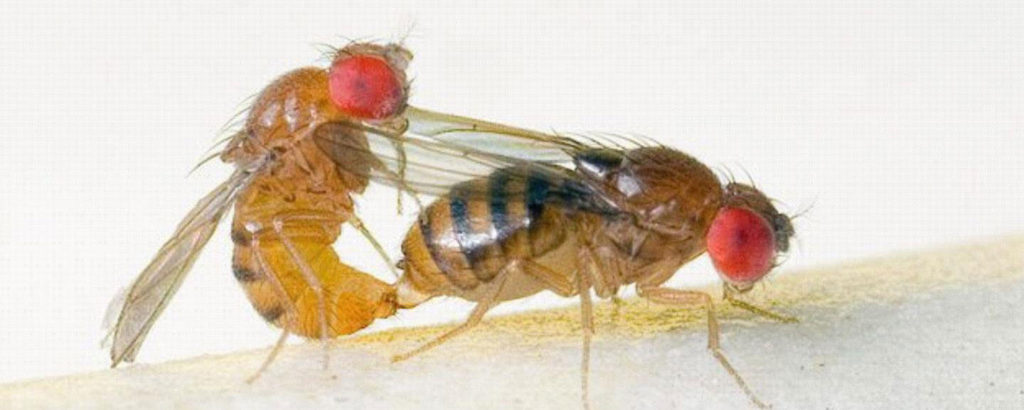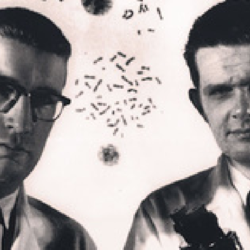Some people have a hard time keeping to the conventional clock. They strongly prefer to sleep and stay up late. Some people show the opposite behaviour; they wake up very early, but are ready for bed well before the late evening news. Although there may be exceptions (teenagers and jazz musicians come to mind), both kinds of behaviour are often related to a changed circadian rhythm. Late sleepers are referred to as “delayed phase” in their circadian rhythm, while those who are exceptionally early to bed – early to rise are said to have “Familial Advanced Sleep Phase Syndrome” (FASPS). People with FASPS have a biological clock that runs about 4 hour ahead of the usual circadian clock; they tend to wake up 4 hours earlier than everyone else, and they begin to fall asleep at a time when most people are interacting socially in the evening.
The biological clock behind circadian rhythm
Circadian rhythm remains only partially understood. Modern biologists are very good at finding the genes and proteins involved in particular activities — we call that kind of research “reductionist”, since it focuses on finding the biological parts involved in a particular activity. Like a mechanic identifying a faulty generator as the problem in the electrical system of a car. But circadian rhythm is controlled by a dynamic biological system comprising a number of molecular components, and even when we know what those are, we are a long way from understanding how they create a 24-hour “clock”. It’s like having a car kit without instructions and trying to figure out how to turn it into a self-propelled vehicle if you’ve never seen a car. You need the instructions, but for circadian rhythm those are still incomplete.
One part of the circadian mystery was uncovered a few years ago when scientists looked closely at the genetic blueprint of a group of people with FASPS. They localized a genetic variation that those people had in common, and they isolated the gene responsible for that difference (1). What that genetic difference told them was that a gene that we know is part of circadian clocks can, if altered, cause FASPS, advanced sleep phase syndrome.
That conclusion was strengthened when the FASPS version of the human gene was transplanted into mice (2). The mice became FASPS mice, with activity cycles shorter by about 4 hours compared to their normal cousins.
The genetic variation that FASPS people carry codes for a protein called “human Period 2”, abbreviated hPER2. It is called that because, in the animals in which it was first discovered, it helps establish the periodicity, the circadian clock cycle time. The changed version in people with FASPS is responsible for the clock running too fast.
The discovery of the per gene
The FASPS-associated hPer2 gene codes for a protein that is just a little different from the usual hPER2 protein. Of the more than 1200 amino acids in the hPER2 protein, there is a single amino acid that’s different between everyone else and the individuals with FASPS. Using the shorthand way of describing protein sequence, where each amino acid is represented by a letter, the standard sequences in that part of the protein is
L A L P G K A E S V
while FASPS people have the sequence
L A L P G K A E G V
The ninth residue in these sequences is different between normal and FASPS; the normal sequence has “S” (the amino acid serine) where FASPS people carry a “G” (glycine).
What does this mean, and why is it important? Serine is one of only three amino acids that contains an —OH group; glycine does not. This —OH group in serine can have a phosphate group attached to it, which is what happens during the circadian cycle. The protein becomes more negatively charged when there’s a phosphate attached (phosphate has a high negative charge). This changes its interaction with other components of the circadian “clock” in a predictable way. So at least a little of the mystery of the circadian clock has been clarified.
From nuisance to genetic trove: Drosophila melanogaster
How do we know about the hPer2 gene at all? We learned from the fruit fly, Drosophila melanogaster, which has been very useful in showing us how genes work. Once the idea of inherited traits took hold at the beginning of the twentieth century, it didn’t take long to see that they underlay all of biology. Genetics started with the Augustinian monk Gregor Mendel, when he published the results of his work with inherited traits in peas in 1866. But Mendel was too far ahead of the thinking of his time; his work wasn’t appreciated until other people did the same experiments 40 years later, only to discover that they were walking on a path he had laid out.
After the re-discovery of genetics in the early twentieth century, other organisms soon became the subjects of genetic studies, including agricultural products such as the Marquis wheat featured in the background image of this site. Among the favourite species for basic studies, however, the tiny fruit fly soon soared to prominence. Fruit flies have advantages, including that they are cheap to house, they reproduce quickly, and they have many easily observed traits, such as the color of their large, compound eyes.

The man who loved flies
Seymour Benzer was one of the people who took up the study of fruit flies, although he came to the party decades after most geneticists had started working with even smaller, simpler, organisms, the bacteria and their viruses. Benzer was born in the Lower East Side of Manhattan of refugee parents. He was a bright boy, and despite his humble origins he went to college and then to graduate school. He became a Ph. D. physicist at the beginning of World War II, and his research on semiconductors soon attracted attention. At the end of the war, the world of physics and technology was his oyster. He was offered academic posts, and plum jobs in industry. He chose academia. But before settling down to do research in physics, his restless intellect led him to take another look at biology, which had been his scientific interest as a boy.
It was a great time to become interested in genetics: the subject was undergoing a revolution, in which the roles of macromolecules such as DNA and RNA and proteins were becoming ever clearer. Benzer studied bacteriophages, which are viruses that attack bacteria, and began to make significant contributions in that field. Thanks to farsighted bosses, he was allowed to do that while retaining a position in (bio)physics. He wasn’t the only former physicist to migrate in this direction — Francis Crick of DNA fame, and many others, were also becoming geneticists.
After some time as a highly productive and well regarded molecular geneticist, Benzer became restless again. He had two daughters, and he could see that, despite growing up in the same house and being treated about the same, they behaved differently. Was there a genetic basis for this difference? Benzer looked around for a system where behaviour could be studied genetically. People were too big and slow, and couldn’t be easily manipulated. Bacteriophage were easy targets for genetics, but lacked behavioural traits. Flies might be the answer. Flies are multicellular, complex, animals, and perhaps the genetics of some kind of behaviour in flies could be probed experimentally? For his third phase of scientific life, Benzer took up the study of flies.
What is behaviour?
Benzer thought he could study behaviour in flies, even though some people disputed the idea that they exhibit what we would recognize as “behaviour”. They just do things. It didn’t matter; the research quickly became so much fun that it was irresistible. Benzer took the same approach that others had pioneered in pushing genetic studies of fruit flies. He subjected them to powerful mutagenic agents (radiation or mutagenic chemicals), and looked to see if anything in the flies’ “behaviour” changed. It did. After a particular round of mutagenesis, he noticed something unusual in their life cycles. It had to do with the time they were born.
Fruit flies go through several steps of development over a period of days. The last stage begins when they emerge from the pupal case as adults. This is called “eclosion”. Flies show a pattern in which they always emerge at certain times of day. But after mutagenesis, Benzer found that a few flies emerged from the pupa at earlier times of the day than usual, and some at later times. Benzer found that the early or late emerging traits bred true – they were stable genetic traits (3). The first gene identified as being involved in this behaviour (the timing of eclosion) was called “per“, for period. The normal, early-emerging, and late-emerging flies carried three different versions of this one gene. In the early emerging flies, the mutation in per was labelled “rapid phase”, and for the later emerging ones, “slow phase”.
Nine years later, there was a bizarre observation about the per gene and its mutations. To understand it, you need to understand how Drosophila “hook up”. To woo the female, male Drosophila carry out a number of courting behaviours, including a song. The “song” is created by rapidly vibrating the wings, and consists of bursts of sound, separated by gaps of silence lasting around 1/20 of a second. The male repeats this pattern until he gets lucky. It turns out that the gaps between bursts of sound are of variable lengths, and they change in a slow, predictable way. They increase, then they decrease, then they increase again. The whole cycle of these changes takes about a minute. There’s a recording of a courting male Drosophila on YouTube here (the song begins about 15 seconds in).
The song cycle of a normal fly, the bursts of sound and the intervening gaps, is a minute long. But for male flies with the “rapid” form of the per gene, the song cycle takes less than a minute. And for the “late” form, it takes over a minute (4). How a genetic variation that changes the 24 hour circadian cycle also changes a song cycle that takes a minute is still a mystery, but it points to the deep significance of circadian rhythm and the molecular machinery responsible for it.
The path from the Drosophila per gene to humans was quite direct. Biology features a great deal of homology, where different organisms have similar genes for carrying out a particular function. And that’s the case, almost, of the per gene in flies and humans: the genes look very similar, so the human version could easily be found once the Drosophila gene sequence was known. But there is a difference: humans have two genes similar to the fly’s per gene, and we talk of hPER1 and hPER2. It’s hPER2 that is involved in the explanation of FASPS.
What’s the connection?
As I said, circadian clocks are imperfectly understood. We know many of the component parts, their genes and their proteins. But how to make a biological clock out of them? Nobody has the complete answer, but from a variety of evidence, the best guess is that the various proteins, including hPER2, interact to regulate gene expression. They increase and decrease the expression of genes, including each other’s, much like an electronic circuit generates oscillations by repeatedly increasing and decreasing current flow. But it’s a work in progress.
There’s a great cartoon of how the circadian clock is thought to work in Drosophila here. You may get confused before you get to the end.
Go to Latest Posts
Reference material
- Toh, K. L., C. R. Jones, Y. He, E. J. Eide, W. A. Hinz, D. M. Virshup, L. J. Ptacek, et al. 2001. An hPer2 phosphorylation site mutation in familial advanced sleep phase syndrome. Science 291:1040-1043.
- Xu, Y., K. L. Toh, C. R. Jones, J. Y. Shin, Y. H. Fu, and L. J. Ptacek. 2007. Modeling of a human circadian mutation yields insights into clock regulation by PER2. Cell 128:59-70.
- Konopka, R. J., and S. Benzer. 1971. Clock Mutants of Drosophila melanogaster. Proc. Natl. Acad. Sci. USA 68:2112-2116.
- Kyriacou, C. P., and J. C. Hall. 1980. Circadian rhythm mutations in Drosophila melanogaster affect short-term fluctuations in the male’s courtship song. Proc. Natl. Acad. Sci. USA 77:6729-6733.





I have learn several excellent stuff here. Definitely worth
bookmarking for revisiting. I wonder how much attempt you put
to create this sort of wonderful informative site.